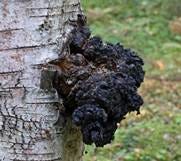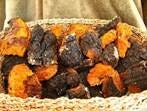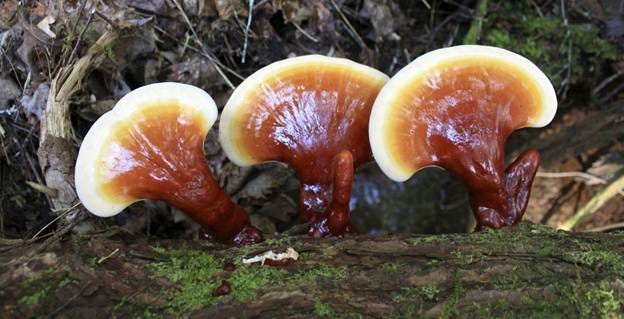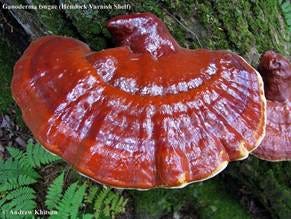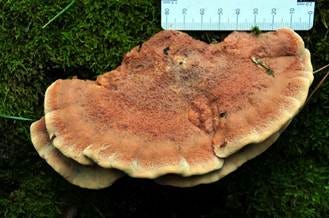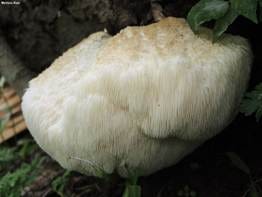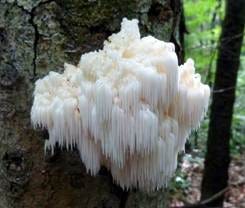Guest Post: A Beginner’s Guide to Mushroom Foraging for Herbalists
learn safe and respectful wildcrafting from The Hemlock Hobo, an outdoor writer and forager with a deep love for mushrooms like chaga, reishi, and lion’s mane.
One of my favorite things about running this community is connecting with others who approach plant and fungi medicine with the same respect and reverence. Today’s guest post comes from The Hemlock Hobo, a fellow Substack writer who focuses on all things outdoors—especially foraging and fungi. While I tend to cover the medicinal actions and phytochemistry of mushrooms, this article is a perfect companion, walking you through the boots-on-the-ground work of learning to forage responsibly and safely. Whether you’re new to mushrooms or just want a grounded perspective on identification, this post delivers a thoughtful and accessible guide to getting started. Enjoy!
Hello readers of the Buffalo Herbalist Community. I am The Hemlock Hobo, another writer here on Substack. The Buffalo Herbalist and I decided to write guest posts for each other’s communities, and it is my pleasure to be writing this article for all of you. I mostly write about the outdoors. That includes fishing, hiking, hunting, and most importantly foraging. I am currently studying for my commercial permit to sell and buy wild mushrooms in the State of Michigan and have been obsessed with mushrooms for a long time. While the Buffalo Herbalist does her job and discusses the medicinal sides of mushrooms, in this article I want to teach you the basics of foraging for mushrooms. I hope this article acts as a gateway into the wonderful world of mycology and connects you to the products you use in herbal practices.
Before I begin, I want to make something very clear. Mushroom foraging can be extremely rewarding, but it can also be extremely dangerous. As herbalists, you all know how powerful plants and fungus can be. Eating the wrong mushroom can make you sick, send you on an unwanted vision quest, or even kill you. There are mushrooms that have no known antidote (Destroying Angel), make you allergic to alcohol (Tippler’s Bane), or create rocket fuel in your body (False Morels) Right now in Australia, a women is on trial for feeding Death Cap Mushrooms to her extended family, killing three of them. The moral of the story is that mushrooms can kill you if you are not careful. I say this not to scare you away from foraging for mushrooms, but to impress upon you the importance of proper identification. In light of what I said, it is important to remember the most important foraging rule. If you are not 100 percent sure that you have correctly identified a mushroom, DO NOT PICK IT. Take a photo and spend some time identifying it online or with an expert. That way, you can be sure that your mushroom is safe, edible, and medicinally effective.
When you are ready to start foraging for mushrooms, the first thing to do is research. The best source of knowledge is an expert. Find someone you know that forages for mushrooms and ask to go with them. Or find someone offering a course and take it. However, I always hate when people online recommend this, because it is out of reach for many. When I started foraging for mushrooms, I didn’t know anyone else who did it, and I certainly didn’t have the money for a course. I totally understand that for someone looking to get into foraging on their own, it can be daunting. For that reason, if you can’t learn in person, a good book or online resource is your best bet. With this, I offer a warning. In recent years, some foul books on mushroom foraging have popped up that have been written entirely by AI. These books offer false identifications and even mark some toxic species as edible. For this reason, I would not use any resource written in the last 2 or 3 years. The other thing to keep in mind is that you should pick a resource based on your general location. The Pacific Northwest and the Midwest for example have very different edible mushrooms, and so a book that specializes in your region will provide the most accurate information. While I can’t recommend a good book, one great online resource for those in the Midwest has been the Midwest American Mycological Information Society, or MAMI for short. Their website has a whole section dedicated to edible species, and it is entirely free. Compared to other resources I have used, their information is easy to understand and very accurate.
When you go foraging, you should forage with a sense of purpose and intentionality. I recommend developing a way to “thank” the forest. As a Christian, I like to pray and thank God for the blessing of the mushroom I have found. I also usually thank the mushroom directly. Your foraging “ritual” could be anything, but developing some little way to give back and pay respects to the woods is really important. It sends crazy (Although given that this is an herbalist community I think you will be more receptive to this than most audiences), but this practice cultivates a sense of respect. Besides the inherent value of respecting nature, by stopping to do something to thank the forest you cultivate a sense of intentionality that can save your life. Even foraging experts make mistakes, often blinded by their own hubris. Taking that moment gives you another chance to double check your identification and make sure that you are comfortable harvesting a given mushroom.
A lot of people conceptualize mushroom foraging as blindly stumbling around the woods hoping to come across a patch of mushrooms. And while there is some truth to that, mushroom foraging often transcends that stereotype. One of my favorite parts about mushroom foraging is that it forces you to learn other things. If I want to find a morel, for example, there are a few places I could look. A Yellow Morel grows under poplars, aspens, and ash trees. So now I need to learn how to identify those. Then, I need to find where those trees live in my area. But they don’t grow all year round, so I need to find out when they grow. Morels sprout when soil temperature hits around 50, but I don’t have a thermometer! So now I need to go and figure out other things that I can use to signify that morels are going to sprout. In my quest to find one mushroom, you learn about a whole ecosystem in the process! Keep in mind when you forage that knowing where, when, and on what a mushroom grows is just as important as what it looks like.
With all that being said, lets talk about some specific mushrooms that are great for beginner foragers. The first is Inonotus Obliquus, otherwise known as Chaga. Chaga is a weird mushroom in that it looks like a big black rock. It is a coal colored lump that exclusively grows on birch trees. It has a cracked and warty exterior, with a yellow-brown corky interior. The easiest way to identify it is to look for lumps of coal on birch trees. It is probably the easiest mushroom on this list to identify. Almost every birch stand will have at least a little chaga somewhere in it. As there are no poisonous look alikes the only thing to keep in mind is that it can only be harvested from living birch trees. Chaga from dead birch trees can be diseased, and there are similar looking fungus that grow on other tree species. As long as you harvest from living birch trees, you won’t have a problem. One quirk of Chaga harvesting is that you can’t just pick Chaga. You usually need a saw or a hatchet to cut the Chaga off the tree, as it grows on and into the tree. When harvesting Chaga, make sure not to cut into the wood of the tree, or it could damage it. Your Chaga should be stored in a breathable bag so that the moisture in it will not rot the Chaga. After harvesting, make sure to dry it at a low heat until it is completely dry. Then, you can break it into smaller chunks which can be stored. Chaga is often brewed as a tea and has a taste similar to coffee. It is said to have many medicinal properties which I’m sure the Buffalo Herbalist can handle better, but residents of Siberia considered it a powerful medicine capable of treating cancer. Chaga is one of my favorite fungus, and a great introduction to foraging!
Chaga on tree
Interior of Chaga
The next mushroom I want to cover is the Reishi mushroom. It is a relative of the Lingzhi mushroom of China, and both are often called Reishi mushrooms. But the one in America is a different species also known as the Hemlock or Varnish Shelf Reishi. It is a polypore mushroom with a very distinctive appearance. It grows in a half moon shape with a thick stem. It changes colors as it ages, going from white to yellow to red. In most specimens the older part of the mushroom will be red, while the younger part will be yellow and the edges will be white. In older specimens the entire mushroom will be red. The entire mushroom has a white pore surface (bottom side). This mushroom grows exclusively on hemlock trees. If it isn’t on a hemlock tree, don’t harvest it! Another good identification for the Varnish Shelf is that it has a extremely glossy shelf, like it has been covered with wood polish. This is pretty obvious once you see it, as it looks and feels like it has been lacquered. Now unlike chaga, Reishi has a few look alikes. Most of them are in the same family as Reishi. One look alike, Ganoderma Resinaceum, can be distinguished from the Reishi because it has softer and more rubbery flesh than the Reishi. But more importantly, the outer growth, when cut or damaged, produces a red resin like tree sap. In addition, the conks are often sessile, which means they lack a stalk/stipe. Ischnoderma Resinosum can look similar to the Reishi, but it has has a soft velvelty texture and does not have the lacquered surface of Reishi, making it pretty hard to confuse with the Reishi. The only poisonous potential look alike is Hapalopilus Rutilans. It produces a potent neurotoxin which can be quite dangerous. The good news is that it can be identified primarily by its dull cinnamon brown color and wrinkled or furrowed appearance. It also has a yellow to brownish pore surface. I know it sounds scary, but as long as you remember that Reishi only grows on Hemlock Trees and has a lacquered, shiny surface, you will be a ok. Reishis bruise easily so make sure you handle the underside with care or their white surface will turn brown. They can be sun dried, but I prefer to cut them into strips and dehydrate them. Reishi is most commonly used as a tea or tincture. It has immune boosting benefits, but again I leave it to the Herbalist herself to better describe their medicinal benefits.
Younger Reishi
Older Reishi
This is the poisonous Hapalopilus Rutilans. Notice the lack of varnish and different color than Reishi. Do not pick it!!
The last mushroom I want to cover is a group known as the Lion’s Mane Mushroom. Lion’s Mane come across as giant coagulations of white spines hanging from a tree, like a beard or a Lion’s Mane (Hence the name). They are white tooth fungus that fruit from late summer to fall. The difference between the species depend on the arrangment and length of the indivual teeth. In general though, it is a solid mass of white teeth which hang in a beard like fashion. There is a tough root like structure that attaches it to trees, and they are found on hardwoods. There are no poisounous look alikes of Lion’s Mane Mushrooms. Coral mushrooms look similar, but they only grow on the forest floor, while Lion’s Mane is only found on hardwood trees. As long as you only harvest them from trees, and they look like clumps of long white teeth you should be ok. Lion’s Mane has a taste remeniscent of seafood, and are supposedly very good for brain health.
Lion’s Mane
Another species of Lion’s Mane with a different tooth presentation.
If you take the time to study your mushroom species and double check your identification, foraging can be a rewarding time foraging. Again, thank you to the Buffalo Herbalist for letting me write!
I absolutely loved the grounded wisdom The Hemlock Hobo shared here. This article is a great reminder that while medicinal mushrooms might show up in our apothecaries as tinctures, teas, or powders, they begin in the living world—anchored to trees, shaped by ecosystems, and carrying stories of their own. I appreciate the emphasis on reverence, ritual, and safety, and I hope this inspires you to connect more deeply with the fungi around you.
Remember, if you’re working with mushrooms medicinally, proper identification is non-negotiable. And if you’re sourcing your own, please harvest mindfully, ethically, and with deep gratitude.
Be sure to check out The Hemlock Hobo's publication for more on the wild outdoors, and stay tuned for my guest post in his corner of the internet soon.
Happy foraging, friends — and as always, thank you for rooting in with me.
-Agy | The Buffalo Herbalist





